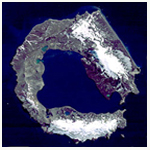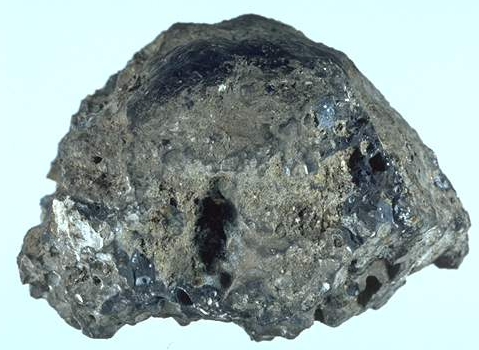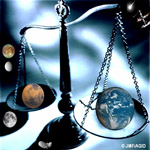Proyectos
En este espacio puedes incluir información y enlaces a tesis, proyectos y actividades de investigación, divulgación científica y comunicación relacionadas con las Ciencias de la Tierra. Envía tus sugerencias al Comité Científico-Técnico de Tierra.
Contacto:
Dr. Jesús Martínez Frías.
Algunos proyectos y actividades:
- ANTARTICA-ASTROBIOLOGY
-
 Volcanism, subaerial and underwater vents, mineralization processes, various types of extreme environments and an extraordinary set of geomarkers for Mars exploration and Astrobiology.
Volcanism, subaerial and underwater vents, mineralization processes, various types of extreme environments and an extraordinary set of geomarkers for Mars exploration and Astrobiology. - MEGACRYOMETEORS
-
 The term megacryometeor was coined in 2002 (Martinez-Frias & Travis 2002) to name large atmospheric ice conglomeration which, despite sharing many textural, hydrochemical and isotopic features detected in large hailstones, are formed under unusual atmospheric conditions which clearly differ from those of the cumulonimbus clouds scenario (i.e. clear-sky conditions). Megacryometeors are not the classical big hailstones, ice from aircrafts (waste water or tank leakage), nor the simple result of icing processes at high altitudes. A detailed historical review of such ice fall events confirms that there are many documented references of falls of large blocks of ice which go back to the first half of the 19th century (previous to the invention of the aircrafts). It also reveals that, mainly after 1950, the number of megacryometeor hits has spectacularly increased. More than 100 events have been witnessed and recorded, affecting practically the whole planet. It is important to note that ice is recognized as a mineral by the International Mineralogical Association, IMA. Considering this apprach, studying the texture and physical properties of the ice crystals, as well as their hydrochemical and isotopic features (as in a quartz, calcite, halite, etc), unequivocally allows us to identify its origin (from lakes, oceans, aircrafts, atmosphere, comets, etc.).
The term megacryometeor was coined in 2002 (Martinez-Frias & Travis 2002) to name large atmospheric ice conglomeration which, despite sharing many textural, hydrochemical and isotopic features detected in large hailstones, are formed under unusual atmospheric conditions which clearly differ from those of the cumulonimbus clouds scenario (i.e. clear-sky conditions). Megacryometeors are not the classical big hailstones, ice from aircrafts (waste water or tank leakage), nor the simple result of icing processes at high altitudes. A detailed historical review of such ice fall events confirms that there are many documented references of falls of large blocks of ice which go back to the first half of the 19th century (previous to the invention of the aircrafts). It also reveals that, mainly after 1950, the number of megacryometeor hits has spectacularly increased. More than 100 events have been witnessed and recorded, affecting practically the whole planet. It is important to note that ice is recognized as a mineral by the International Mineralogical Association, IMA. Considering this apprach, studying the texture and physical properties of the ice crystals, as well as their hydrochemical and isotopic features (as in a quartz, calcite, halite, etc), unequivocally allows us to identify its origin (from lakes, oceans, aircrafts, atmosphere, comets, etc.). - GEOLOGÍA PLANETARIA
- Un Foro científico común para España e Iberoamérica (desde 1998), donde los estudios sobre material extraterrestre, recursos geológicos del espacio y en general, geología planetaria, pueden ser abordados de forma conjunta. Únete a nosotros.
- METEORITO DE RELIEGOS
- The Reliegos meteorite is the real last meteorite “fall” recovered in Spain. Other meteorites which were recovered after 1947 (Villalbeto de la Peña and Puerto Lápice) are “finds”. In these last events, there were no direct witnesses, and no meteoritical pieces were collected coinciding simultaneously with the observation of the bolides.
- ROCA DE GETAFE
-
 Getafe was officially catalogued for our research group in 2002 as a “pseudometeorite” in the meteorite collection of the National Museum of Natural Science, Madrid (Spain). This contribution was also presented in the Iberian Congress of Meteorites and Planetary Geology. The possibility that Getafe could have a man-made origin (i.e. ceramic and refractory tiles, industrial slag) was internationally considered and proposed, by the first time, in 1999 in our article co-authored with Prof. Kurt Marti, T. Jull and other colleagues.
Getafe was officially catalogued for our research group in 2002 as a “pseudometeorite” in the meteorite collection of the National Museum of Natural Science, Madrid (Spain). This contribution was also presented in the Iberian Congress of Meteorites and Planetary Geology. The possibility that Getafe could have a man-made origin (i.e. ceramic and refractory tiles, industrial slag) was internationally considered and proposed, by the first time, in 1999 in our article co-authored with Prof. Kurt Marti, T. Jull and other colleagues. - GEOLOGÍA MARINA
- MARiNET tiene como objetivo fundamental propiciar la interacción electrónica entre personas interesadas en preservar el medio-ambiente marino y profesionales de Universidades, Organismos Públicos de Investigación, Empresas, Entidades e Instituciones públicas y privadas dedicadas a la gestión e investigación del mar. En definitiva, el objetivo es constituir un marco común donde los científicos y, en general, los investigadores -en el sentido más amplio del término- dedicados al Medio Ambiente e Investigaciones Marinas puedan reunirse electrónicamente, dar su opinión, presentar y debatir propuestas.
- METALOG
- Procesos metalogeneticos en sistemas magmaticos e hidrotermales. Grupo 910197 UCM en el que participan investigadores de distintos organismos e instituciones académicas y científicas.
- COLTAN
- Aunque muchos compuestos artificiales constituyen una base muy importante como materiales estratégicos para la industria, la Naturaleza es capaz de generar recursos geológicos y materias primas minerales cuyas aplicaciones superan, con mucho, las obtenidas en el laboratorio. Desafortunadamente esto genera también problemas y conflictos con gravísimas repercusiones sociales y humanas. El Coltan es un claro ejemplo de ello. Un material clave, entre otros sectores, para la microelectrónica, telecomunicaciones e industria aero-espacial. Además, su resistencia y singulares propiedades físico-químicas le hacen privilegiado como futuro material de uso extraterrestre en la Estación Espacial Internacional y futuras plataformas y bases espaciales.
- JAROSITA
-
Jarosite: a significant Spanish mineral for the geological and astrobiological exploration of Mars. Jarosite was first characterized as a new mineral on Earth in Spain in 1852 in the Jaroso Ravine, which is the world type locality. The SE Mediterranean margin of Spain is an area of synchronous interaction of tectonic, volcanic, evaporitic and mineralizing hydrothermal processes. The Jaroso Hydrothermal System (JHS) is an extremely interesting late-volcanic episode, and the Jaroso Ravine, located in Sierra Almagrera (Cuevas del Almanzora area, Almeria province, SE Spain), is the best outcrop where the mineralization (Jaroso vein) and alteration, have attained the maximum surface expression.
-
- CANARIAS
- Canarias, particularmente Tenerife, constituyen un marco privilegiado para la colaboración multidisciplinar en relación con Meteoritos y Geología Planetaria, desde el punto de vista científico, docente, museístico y de divulgación. El Museo de Ciencias Naturales de Tenerife aloja una de las mejores colecciones de meteoritos de España, cuya investigación y catalogación están en fase de desarrollo y que también son fundamentales para la realización de cursos y seminarios museísticos y de divulgación científica. Asimismo, ya se han iniciado en Tenerife estudios científicos y tecnológicos que demuestran la importancia del archipiélago como plataforma científica de primera magnitud para la realización de estudios de geología planetaria, de caracterización espectroscópica mineral y de astrobiología.
- GEOÉTICA
-
 Despite the term being used with various meanings, Geoethics was born in 1991 at the junction of Ethics and Geology. Dr. Vaclav Nemec (since 2004 Vicepresident forEurope of the Association of Geoscientists for International Development - AGID, Head of the AGID Working Group for Geoethics, Krumbein Medalist of the International Association for Mathematical Geology) is considered the father of this discipline. Geoethics is a key discipline in the field of Earth and Planetary Sciences , which involves scientific, technological, methodological and social-cultural aspects (e.g. sustainability, development, museology), but also the necessity of considering appropriate protocols, scientific integrity issues and a code of good practice, regarding the study of the abiotic world. Studies on planetary geology (sensu lato) and astrobiology also require a geoethical approach. (Martinez-Frias, J. (2008) Geoethics: proposal of a geosciences-oriented formal definition and future planetary perspectives. TIERRA: Spanish Thematic Network of Earth and Planetary Sciences. http://tierra.rediris.es. RedIris. Documentos, 2008, 1.).
Despite the term being used with various meanings, Geoethics was born in 1991 at the junction of Ethics and Geology. Dr. Vaclav Nemec (since 2004 Vicepresident forEurope of the Association of Geoscientists for International Development - AGID, Head of the AGID Working Group for Geoethics, Krumbein Medalist of the International Association for Mathematical Geology) is considered the father of this discipline. Geoethics is a key discipline in the field of Earth and Planetary Sciences , which involves scientific, technological, methodological and social-cultural aspects (e.g. sustainability, development, museology), but also the necessity of considering appropriate protocols, scientific integrity issues and a code of good practice, regarding the study of the abiotic world. Studies on planetary geology (sensu lato) and astrobiology also require a geoethical approach. (Martinez-Frias, J. (2008) Geoethics: proposal of a geosciences-oriented formal definition and future planetary perspectives. TIERRA: Spanish Thematic Network of Earth and Planetary Sciences. http://tierra.rediris.es. RedIris. Documentos, 2008, 1.).



